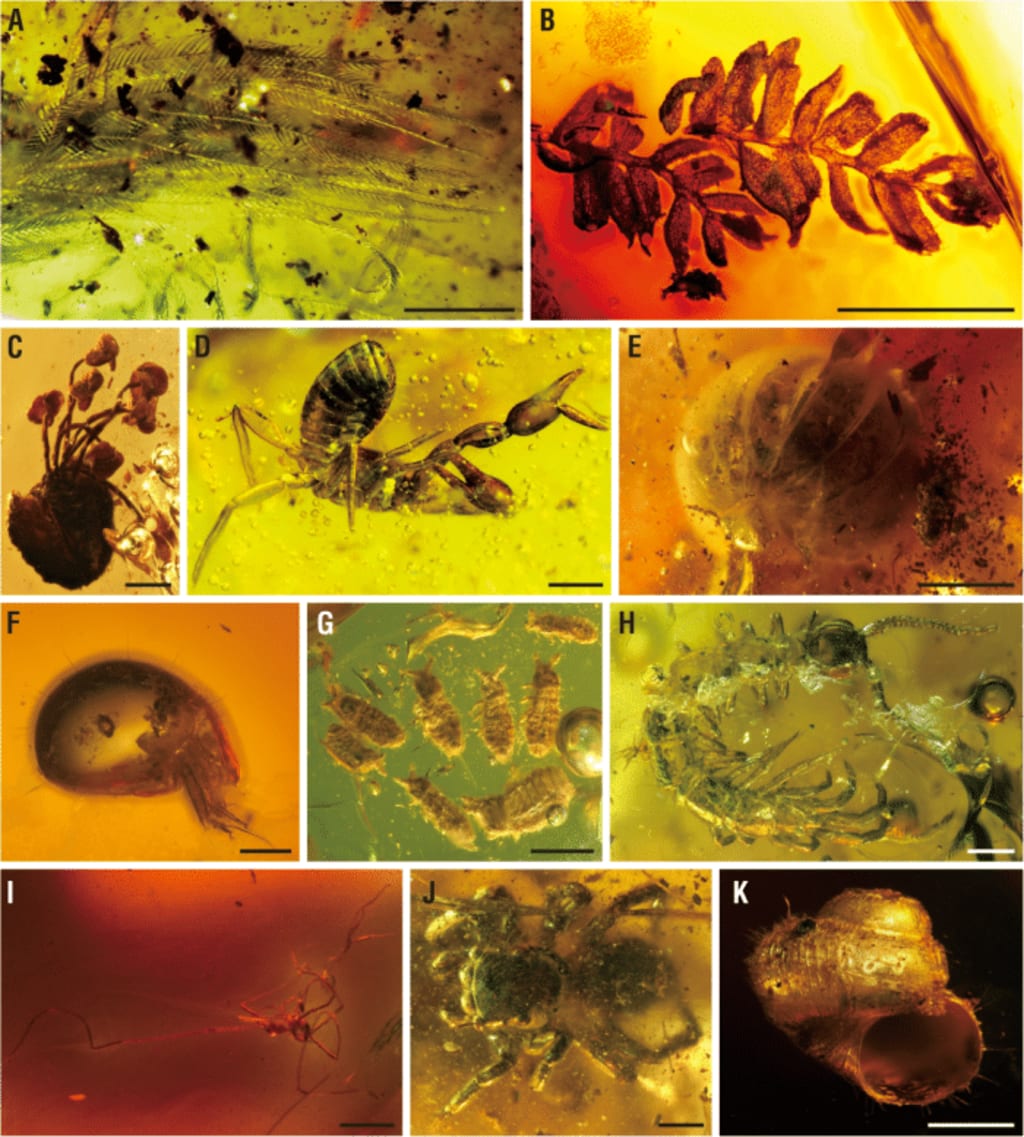Some scientists not only do not have a holiday, but are also ready to tell you a discovery of "10 years of sharpening a sword"
Some scientists do not have a holiday, but they are also ready to tell you a discovery of "grinding a sword in ten years"

As we all know, the Labor Day holiday should be more labor (obviously not). Scientists are even more familiar with this principle, and they have found a large-scale er who advocates "studying more seriously during holidays", and talk to you about the discovery of "hardening a sword in ten years".
This discovery is the Zhangpu Biota, a tropical rain forest fossil repository located in Fujian. Over the past decade, a joint team of 30 researchers from multiple disciplines led by Wang Bo and Shi Gongle from the Nanjing Institute of Geology and Palaeontology, Chinese Academy of Sciences, has conducted detailed studies on the diversity, paleoecology and paleoclimate significance of this biota. .
The past is the key to understanding future environmental changes, and fossils are undoubtedly the most important of them. In 2010, the Zhangpu Biota was discovered in the Fotan Group strata in Zhangpu County on the southeastern coast of Fujian. As a set of rock layers interbedded with sedimentary rocks and volcanic rocks (that is, the two types of rock layers appear repeatedly), they are mainly distributed in Zhangpu County and Longhai County in southern Fujian, and Mingxi County and Ninghua County in western Fujian. The era (about 14.7 million years ago) was in the late Miocene climatically suitable period.
The Middle Miocene Climatic Optimum, which appeared in the middle Miocene 17-14 million years ago, was a strong warming event in geological history. At that time, the content of carbon dioxide in the atmosphere was significantly higher than the current level, and the global annual average temperature was 3-7 °C higher than today, which is very similar to the current climate and environment predicted in 2100. Therefore, understanding the changing process of climate and biota in this suitable period is of great significance for predicting future changes in climate and biota under the background of global warming, and can help human beings to deal with future environmental crises more efficiently.
Although many mid-Miocene fossil taxa have been discovered, our understanding of tropical biota from this period is still very limited. The Zhangpu biota can provide rich fossil data for related research. So, how are these fossil materials preserved?
During geological history, when there were flash floods or heavy rains, some plant leaves that fell off in autumn were washed into creeks and eventually flowed into rivers or lakes. When the lake buries rapidly, sediments cover it up. In a very rare case, these leaves were preserved and became what we call fossil plants today. These plant fossils are the main symbols for the division and restoration of ancient continents, paleoclimates and phytogeographical divisions in the geohistorical period.
After 10 years of continuous field collection, the research team has obtained more than 25,000 insect-bearing amber and more than 5,000 plant stamping/imprinting fossil specimens. Among the ancient flora, the groups with the highest diversity and the most abundant fossil specimens include Dipterocarpaceae, Leguminosae, Lauraceae and Garciniaaceae. Euphorbiaceae, Paeoniaeaceae, Moraceae, Myristicaceae and Myrtaceae are the dominant groups in the tropical rainforests of Southeast Asia today. Among them, plant leaf fossils include 2 species of ferns, 3 species of monocotyledonous plants, 78 species of dicotyledonous plants, and more than 20 species of fruit and seed fossils. Based on the species of animal and plant fossils that have been discovered, the Zhangpu Biota has become the world's most species-rich Cenozoic tropical rainforest fossil bank.
Not only that, many ambers were also found from Zhangpu biota. Amber is a very special fossil formed after a long period of geological action after the ancient plant resin was buried in the ground. The contents of Zhangpu amber are very rich and have important research significance. The Zhangpu amber found so far comes from the Dipterocarpaceae plant. The resin of the Dipterocarp tree was brought into the lake after dripping, and was deposited and preserved together with plants and clay.
my country is a big country with extremely rich fossil resources. However, as a special fossil, amber (especially worm amber) is rarely found in my country, and only one Fushun amber origin is widely known. Discovering the world's top amber biota on one's own soil is every palaeoentomologist's wish. Since Mr. Bingzhi first started the research on Chinese amber in 1931, after the efforts of several generations of Chinese paleontomologists, this wish was finally realized 90 years later.
In 2014, the amber research team of the Nanjing Institute of Paleontology reported the appearance and composition of the amber biota in Fushun (Current Biology, 2014), making it one of the most diverse amber biota in the world, filling in the Eocene period of Asian continental amber. The gap in the biota indicates that there was extensive biological communication between the two ends of the Eurasian continent 50 million years ago; the team also reported for the first time in 2018 the features of the late Cretaceous Tylin amber biota in Burma (Nature Communications, 2018) The 24-million-year-old gap in insect fossils has been supplemented, greatly helping scientists understand insect evolution before and after the end-Cretaceous mass extinction event. Today, the Zhangpu amber biota is the third multidisciplinary and systematically studied amber biota completed by the team. This biota is the most abundant amber biota newly discovered in the past 100 years, and is one of the four largest amber biota in the world. The discovery also shows that my country is a country rich in amber resources.
Zhangpu amber contains a large number of animal and plant fossils. From the perspective of arthropod diversity, the Zhangpu amber biota currently ranks third in diversity with 250 families that have been discovered, second only to the Kachin amber biota in Myanmar (mid-Cretaceous, about 100 million years ago; nearly 600 family) and the Baltic amber biota (Eocene, about 48-34 million years ago; nearly 600 families), higher than the Dominican amber biota (mid-Miocene, about 20-15 million years ago; about 200 families) .
In the found amber, insects are the most abundant, including at least 20 orders and 200 families. The most common is Diptera, accounting for about 55% of the total; followed by Hymenoptera (various bees and ants); again Coleoptera (beetles) and Hemiptera (aphids, cicadas, bugs, etc.). In addition, amber also contains a large number of feathers, plants, gastropods and microbial fossils.
Unlike most other ambers, Zhangpu amber has precise geological age and paleoclimate data, which can be used to clearly understand the environmental context of amber biota. Most of the arthropods (especially ants, bees, springtails, crickets, mosquitoes, etc.) in the Zhangpu amber biota are extant genera, providing a good time correction point for the molecular systematic study of various groups. . The stability of the genus class indicates that the Asian tropical rainforest biota reached its present ecological structure as early as 15 million years ago, which also supports the view that "tropical rainforest is a museum of biodiversity".
More importantly, the Zhangpu amber biota is also the most abundant amber biota for scientific research collection (non-commercial mining), completely retaining the initial paleoecological and burial information, which is helpful for the paleoecological restoration and development of other amber biota. Burialology (fossil formation) bias correction provides valuable comparative data.
Taking history as a mirror to know about climate change
After research and analysis, both the flora composition and the foliar composition of the flora show that the Middle Miocene flora of Zhangpu represents a tropical monsoon forest, and its foliar composition is very similar to that of present-day central Thailand, central India and the Ganges delta. Paleoclimate analysis of plant fossils shows that the Zhangpu area was located at the northern edge of the tropics during the Middle Miocene, with an average annual temperature of 22.5 ± 2.4 °C, an average summer temperature of 27.1 ± 2.9 °C, and an average winter temperature of 17.2 ± 3.6 °C. About 12 months, the precipitation in the growing season was 1929 ± 643 mm, and spring was the driest season. The Miocene summer temperature in the Zhangpu area quantitatively reconstructed by leaf facies analysis was about 10 °C higher than that in winter, which was lower than the current seasonal temperature difference in Zhangpu (about 15 °C). In addition, the difference of seasonal precipitation in the Zhangpu area during the Middle Miocene is close to that of today.
At the same time, the Zhangpu biota fossils contain a large number of typical Southeast Asian tropical biological groups, such as some flowering plants, mosses, snails, spiders, and many ants, bees, crickets, beetles and other insects, which are currently only distributed in the Southeast Asian tropical rainforest area. (even northern Oceania). In the context of the Mid-Miocene greenhouse effect, the winter minimum temperature in Zhangpu area increased significantly, weakening the winterkills, which may be the most important factor leading to the northward migration of tropical biota. The "Northern Expedition" movement of tropical biota brought a large number of invasive species and caused changes in local biological chains, biogeochemical cycles and climatic conditions, which may have strongly affected the original biological groups in East Asia and further shaped today's East Asian Biota.
"Ten years to sharpen a sword", this research result is the crystallization of ten years of hard work and selfless dedication of all team members. This study is the preliminary result of the Zhangpu biota, focusing on showing the general appearance of the Zhangpu biota, but there are still a large number of fossils that need to be identified in detail (for example, only more than 8,000 worms have been identified so far). The research team will successively carry out in-depth taxonomic, phylogenetic and paleoecological research on some important animal and plant groups. This study also provides an important reference for understanding the evolution of modern Asian tropical rainforest ecosystems and how they respond to future warming.
Relevant research results are provided by Nanjing Institute of Geology and Palaeontology, Chinese Academy of Sciences, University of Chinese Academy of Sciences, Xishuangbanna Tropical Botanical Garden, Chinese Academy of Sciences, Institute of Zoology, Chinese Academy of Sciences, Sun Yat-sen University, China Agricultural University, Capital Normal University, Linyi University, Qufu Normal University, The University of Hong Kong, The Open University of England, Germany University of Göttingen, University of Munich, Senckenberg Museum of Natural History, French Museum of Natural History, University of Rennes, Indiana University at Urbana-Champaign, American Museum of Natural History, University of Kansas, University of Gdansk, Poland, Lebanon University The international research team worked together. The related research was published online in Science Advances on April 30, 2021.
The research work was funded by the Chinese Academy of Sciences, the Ministry of Science and Technology, and the National Natural Science Foundation of China. The Fujian Institute of Geological Survey and Zhangzhou Binhai Volcano National Geopark provided important support for the development of this study. Mr. Zhu Li, a fossil enthusiast, discovered many new amber deposits and carried out long-term collection work, grinding more than 20,000 specimens, which provided important support for this amber research. Mr. Shen Huazhu provided a lot of support for Zhangpu fossil collection.
references:
[1] Wang Bo*, Shi Gongle*, Xu Chunpeng, Spicer R.A., Perrichot V., Schmidt A.R., Feldberg K., Heinrichs J., Chény C., Pang Hong, Liu Xingyue, Gao Taiping, Wang Zixi, Ślipiński A ., Solórzano-Kraemer M.M., Heads S.W., Thomas M.J., Sadowski E.-M., Szwedo J., Azar D., Nel A., Liu Ye, Chen Jun, Zhang Qi, Zhang Qingqing, Luo Cihang, Yu Tingting, Zheng Daran, Zhang Haichun, Engel M.S. (2021) The mid-Miocene Zhangpu biota reveals an outstandingly rich rainforest biome in East Asia. Science Advances, 7: eabg0625. https://doi.org/10.1126/sciadv.abg0625.
About the Creator
witty lukas
The doubts held by human beings are the germs of science






Comments
There are no comments for this story
Be the first to respond and start the conversation.